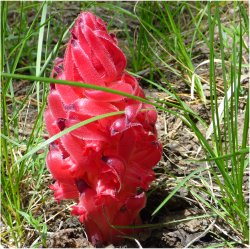
Lizard blending in with a lichen-spotted rock Humans and animals have been attracted to this unique place for a long time. An interpretive panel inside the park names four major habitats of the Huffaker Hills and surrounding areas: sagebrush chaparall, high bunch grass prairie steppe, low bunch grass meadow and bulrush marsh. The Huffaker hillsides mainly feature rocks and sagebrush and—during late winter and spring months—colorful lichen and various flowering plants. In the past, one would have found Pronghorn antelope, Mule deer, Bobcat, Coyote and Badger (according to the panel). Animals commonly seen today during the hot and dry season are rabbits, snakes and lizards. We further learn that about one hundred bird species are found in sagebrush habitat including the sage thrasher, sage sparrow, Brewer's sparrow, western bluebird, mourning dove, quail and sage grouse. The latter won't be found at Huffaker. But raptors on the hunt and migratory shorebirds can be viewed—as well as low-flying airplanes leaving or approaching Reno-Tahoe International Airport. |
||||||
The most dominant shrub is the aromatic evergreen species Artemisia tridentata, called big sagebrush or simply sagebrush. A few ephedra plants, known as Mormon Tea or Indian Tea, grow within the Huffaker sagebrush chaparall. The “Sagebrush galls” picture at left features the sagebrush leaves with their three-lobed ends, hence the scientific name Artemisia tridentata (tridentata meaning three-toothed). Sagebrush doesn't bite, but a rattle snake, hiding in sagebrush shade, might. Sagebrush leaves with two or four lobes are also found. The picture shows thumb-sized, greenish white to pink galls on the leaves. Such galls may occasionally be found on individual shrubs. The galls are an abnormal growth caused by insects, which use them as shelter for themselves and their larvae. A limited amount of galls do typically not harm the plant. 
Buckwheat The buckwheat family (Polygonaceae) is rich in species. The Tahoe Wildflowers Guide by Laird R. Blackwell (Morris Book Publishing, 2007) features two species with yellow flowers, cushion desert buckwheat (Eriogonum caespitosum) and ochre-flowered buckwheat (Eriogonum ochrocephalum), which like to grow on dry slopes. Other Polygonaceae of the Reno/Tahoe area are altered andesite buckwheat (Eriogonum robustum) and Lobb's buckwheat (Eriogonum lobii). |
|
Tweet
__ __ 
__ 
|
|
| Huffaker Hills Open Space |
|
Huffaker Hills Trailhead and Park Beckwith violet September 2010 brush fire Reno's Huffaker Hills Trailhead Huffaker Park Lookout Trail German-language version of this page |
|
|

Trailing Ahead |
| Video Maker |

Custom Search
|





